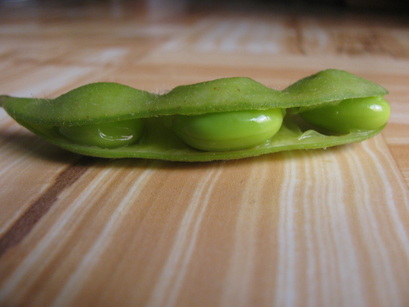
As promised, today's edition of Mostly Plants will focus on edamame. This succulent little soybean snack is a personal favourite, and is becoming an in-demand appetizer as Western palates fall further in love with Japanese cuisine.
Essentially, edamame is a word for boiled soybeans that have been picked while the pods are green and the beans have yet to harden. Though they do come pre-shelled, eating edamame often means popping the beans from the pod with your fingers or lips. It's a satisfying action, and the beans themselves are subtly sweet.
Fun to eat, yes, but edamame's major selling point is nutritional. This plant is packed with protein and has good, cholesterol lowering fats (polyunsaturated, the kind you find in fish like salmon). In one and a quarter cups of unshelled edamame there are 120 calories, 11 grams of protein, 2 grams of unsaturated fat, a good dose of fibre and last but not least, 10% of your daily recommended intake of iron, something few of us get enough of. Yes, some concerns have been raised about soy. Skip to "know your plants" to hear about those.
Shelled or in-pod edamame is found in the freezer aisle. I had some difficulty tracking it down at my local grocery in Montreal (finally found some at Eden on Prince Arthur and Parc), but it was in stock everywhere in Toronto. If your supermarket doesn't provide, a specialized Japanese grocery is the next place to look. My 400g bag set me back $2.29.
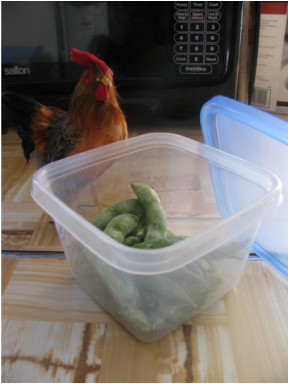
Buying: Hit the frozen food aisle.
Cooking: This takes about 2 minutes by microwave and stovetop. Yes, I'm using the stovetop.
Microwave:
1.Throw your edamame into a microwave safe container.
2. Add a smidgen of water in the bottom.
3. Partially cover and cook on high for two minutes.
4. Drain the water, and add some salt for taste if you please.
Boiling:
Remember how I said too much water is bad for nutrients? Well, instead of giving you measurements, I'll just advise you to use just enough water so that the beans are covered. This will be hard to estimate because the water has to boil before you put in the beans, but guess less since you can always add more.
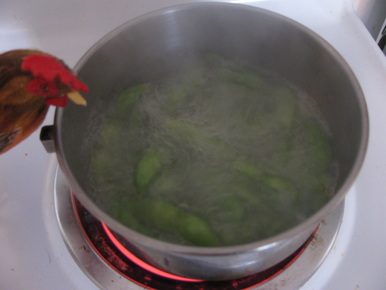
1. Add salt to your water and bring it to a boil.
2. Once you're boiling, carefully submerge your edamame keeping the bean to water ratio high.
3. Boil for two minutes.
4. Drain the water and add some salt to taste.
Though I hate to admit it, the stovetop edamame was nicer to eat than the microwave edamame, if only by a little bit.
Know your plants:
Some people credit the 1980 television miniseries Shogun as the beginning of America's love affair with Japanese cuisine. Sapporo and edamame were the Japanese answer to Budweiser and peanuts. Edamame actually has its roots in China, where it was first domesticated and literary references date back two-thousand years.
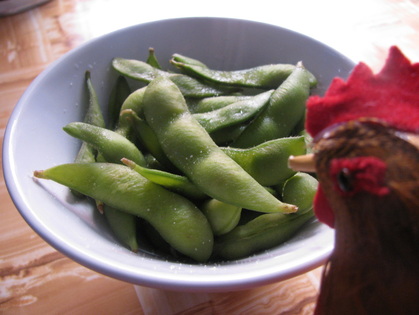
Most edamame soybeans are imported from China. Soy is a relatively new crop to Canada and is grown largely in Southern Ontario where the weather is warmer. In terms of profitability, soy comes in just after corn as the fifth most valuable crop in Canada, and its importance is expected to grow.
Soy is really good for feeding livestock since it's so high in protein. However, for animals to access this protein the beans must be processed into soymeal. Since Canada currently lack the facilities required, 99% of our feed grade soy comes from -you guessed it- the United States. The production of soymeal has increased operating efficiency and enabled the growth of -guess again- factory farming.
If you've been reading foodie literature in the past few years, you'll notice that soybeans have been both overly hyped as our dietary saviour, and suffered a subsequent botanical backlash. We love soy for its protein, but worry that the protein depresses thyroid function. We love its fats compared to animal tissue, but are afraid its estrogen-like components make our boys girly and our girls into women too soon. The fact is, many soy-studies are conducted on rats who are more susceptible than humans on both these fronts. At the bottom line moderation is key. I know two things to be true: soy is good for you, and humans need variety.

Overall, Soybeans are a huge winner in my book. The pod-popping experience slows down my meal. Instead of guzzling handful after handful of Lays, I spend a little time and savour each bean. As someone who is inexperienced with (and afraid of) cooking meat, it feels good to know that I'm getting my protein without the health risks associated with meat (and not just the ones that involve improper food handling).
That’s it for now! Check back on March 24th as we press on for more ground-grown goodness. I recently discovered Arugula, and if you haven’t, you should too.
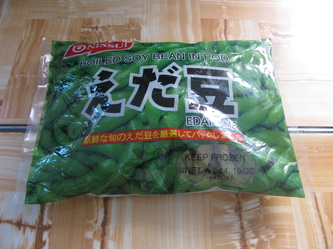
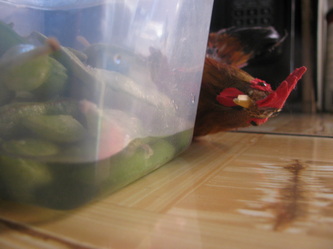
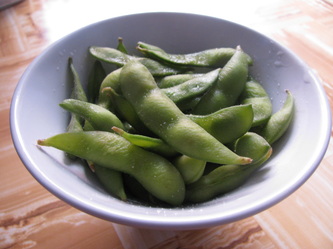
 RSS Feed
RSS Feed